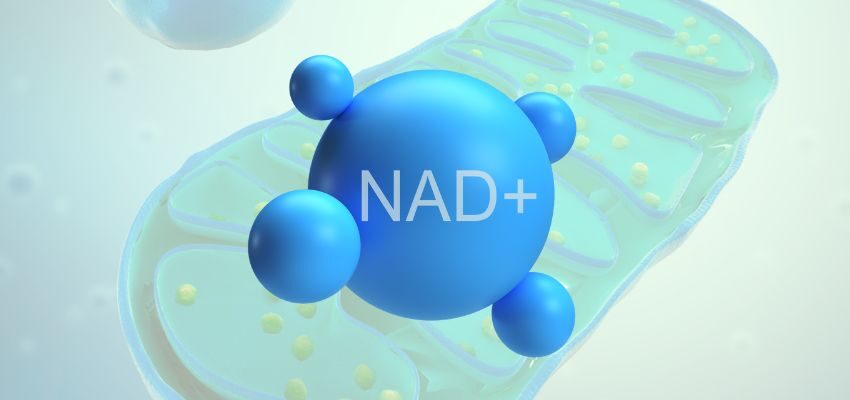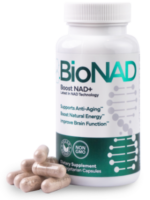The Power Of NAD+ And NRF2 Activation For Longevity

Published March 6, 2025
Lung cancer cells with KEAP1 mutations are hard to target. New findings reveal a key weakness. NRF2 activation and NADH-reductive stress create unique metabolic pressures. Combined with Complex I inhibition, these could open doors to new treatments.
In this article, we’ll explore the mechanisms of NAD+ and NRF2 activation. We’ll examine their roles in cell growth and proliferation. We’ll also look into their link to tumorigenesis, a process where normal cells undergo transformation into cancer cells.
What Is NRF2?
NRF2 (Nuclear factor erythroid 2-related factor 2) is a protein that acts as a transcription factor, protecting cells from oxidative stress and toxic damage. It regulates genes for antioxidant defense, detoxification, and cellular balance. By activating these genes, NRF2 helps cells combat harmful reactive oxygen species (ROS) and other stressors, supporting their survival and health.
Usually kept inactive by KEAP1, NRF2 is released during stress and moves to the nucleus to trigger protective responses. This process helps prevent damage linked to diseases like cancer and neurodegeneration.
The Influence Of NRF2 Activation And NADH-Reductive Stress
NRF2 activation is key to cellular metabolism. It increases the NADH/NAD+ ratio in KEAP1-dependent lung cancer cells, causing NADH-reductive stress, an imbalanced state. The disruption affects NADH homeostasis, which is vital for normal cell function.
Excess NADH disrupts energy production and key cellular functions. It affects redox signaling, metabolic pathways, and cell proliferation. Maintaining NADH balance is crucial for supporting NRF2 activity. This link between metabolism and cancer cell survival reveals potential treatment opportunities. It offers insights critical to future therapies.

The Role Of KEAP1 Mutations And Complex I Inhibition
KEAP1 mutations are crucial in the metabolic vulnerability of lung cancer cells. They heavily influence cell behavior and survival. Inactivating KEAP1 keeps NRF2 active. NRF2 is a primary regulator of the oxidative stress response.
This activation triggers metabolic reprogramming. It helps cancer cells adapt to and survive oxidative stress. However, it also creates unique metabolic weaknesses. These can be targeted for therapeutic purposes.
Complex I inhibitors target a key enzyme in the mitochondrial electron transport chain. They show promise in stopping the growth of NRF2-activated cells by disrupting their altered energy production. KEAP1 mutations and NRF2 activation create unique metabolic weaknesses. These insights open new opportunities to improve lung cancer treatments.
The Connection Between ALDH3A1 And NADH Regulation
The enzyme ALDH3A1 is essential for mitigating NADH-reductive stress in KEAP1-dependent cells. It works by converting reactive aldehydes into stable carboxylic acids, which are common byproducts of oxidative stress in cells. This process helps preserve the cellular redox balance, regulates NADH levels, and supports overall cellular stability.
Increased ALDH3A1 activity can result in NADH accumulation, triggering reductive stress. Research shows that lowering ALDH3A1 levels can help. It overcomes the proliferation block seen in KEAP1-dependent cells after NRF2 activation.
Depleting ALDH3A1 restores mitochondrial respiration. This enzyme links redox balance to metabolic adaptation in these cells. The discovery shows its potential as a therapeutic target. It may help address conditions related to KEAP1-NRF2 dysregulation.
Therapeutic Opportunities
Targeting metabolic weaknesses in lung cancer cells offers new treatment options. Key strategies include activating NRF2 and addressing NADH-reductive stress. These dependencies create unique opportunities for therapy. Disrupting these pathways could help slow or stop cancer progression.
Strategies include using NAD+ precursors to restore redox balance and reduce reductive stress. Another approach targets glycolysis, disrupting cancer cells’ energy production and metabolic flexibility.
These strategies target specific vulnerabilities in lung cancer. They offer innovative and effective treatment options. They can be used alone or combined with existing therapies.
Frequently Asked Questions
Can you explain the relationship between NAD+ and NRF2 activation?
NRF2 activation increases the expression of antioxidant and metabolic genes, including genes involved in NAD+ biosynthesis and recycling. It helps maintain the NAD+/NADH balance, supporting cellular redox stability, which is crucial for managing metabolic and oxidative stress.
How does NRF2 activation lead to NADH-reductive stress?
Overactivation of NRF2 disrupts redox balance. This causes an excess of NADH compared to NAD+, known as NADH-reductive stress. The imbalance affects cellular metabolism. It also impairs oxidative phosphorylation, reducing normal energy production.
How does reductive stress affect cancer cell growth and proliferation?
Reductive stress helps cancer cells survive and grow. It reshapes their metabolism, increasing glycolysis and reducing mitochondrial function. However, this adaptation creates weaknesses. Cancer cells become dependent on specific pathways to manage stress.
How does reductive stress affect the metabolic and oxidative stress of cells?
Reductive stress happens when the balance between oxidative and reductive states is disrupted. This leads to metabolic dysfunction. It can impair mitochondrial function and increase reactive oxygen species (ROS). It also reduces the cell’s ability to fight oxidative stress. Over time, these effects can compromise both cell function and survival.

Why Take NAD Supplements?
NAD+ supplements, like BioNAD, help restore cellular redox balance. They replenish NAD+ levels and reduce NADH-reductive stress. This is important for conditions like KEAP1-mutant lung cancer, in which NRF2 activation disrupts the NAD+/NADH balance. Boosting NAD+ can improve metabolic function and support oxidative phosphorylation, which are key for maintaining cellular health.
BioNAD is a powerful choice. It’s formulated for purity and high bioavailability to deliver results. Its advanced formula enhances mitochondrial function and reduces oxidative stress. It also supports overall cellular health. While research continues on NRF2-driven cancers, BioNAD provides a trusted, science-backed solution. It supports NAD+ metabolism and cellular function.
The Future Of Cancer Therapy: Targeting NAD+ And NRF2 Activation
Key metabolic vulnerabilities in lung cancer are linked to NAD+ and NRF2 activation and NADH-reductive stress. Overactivation of NRF2 disrupts redox balance, creating metabolic dependencies that cancer cells need to survive and grow. By exploring these weaknesses, targeting NAD+ and NRF2 pathways could lead to new lung cancer treatments. Further research could provide new insights into cancer metabolism and therapy development.

Try BioNAD Now & Experience The Boost!
NAD+ (Nicotinamide Adenine Dinucleotide) is a crucial coenzyme found in every cell of your body, playing a vital role in cellular energy production and metabolism. BioNAD supplements aim to elevate your NAD+ levels, providing numerous health benefits.

About The Author
Meet Corinne Grace, a nurse with a passion for writing. Her expertise lies in health and wellness topics, where she blends academic knowledge with engaging story telling.

This Content Has Been Reviewed For Factual Accuracy
This content has undergone thorough fact-checking by our team of experts. Learn more about the editorial standard for our website here.




